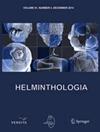ACV 加/不加 IVM:螺旋体旋毛虫感染期间肠道 CDX2 和肌肉 CD34 及细胞周期蛋白 D1 的新发现
IF 1.2
4区 生物学
Q4 PARASITOLOGY
引用次数: 0
摘要
摘要 本研究评估了阿昔洛韦(ACV)和伊维菌素(IVM)作为单一疗法和联合疗法对螺旋毛线虫肠道和肌肉阶段感染的疗效。100只瑞士白化小鼠口服250 ± 50条感染性幼虫,并被分为未受感染组(第1组)、IVM治疗组(第2组)、ACV治疗组(第3组)、IVM+ACV联合治疗组(第4组)和健康对照组(第5组)。每组又分为亚组-A-肠道期(10 只小鼠,第 7 天后处死)和亚组-B-肌肉期(10 只小鼠,第 35 天后处死)。记录存活率和体重。对寄生虫负荷和肠道组织病理学进行评估。此外,还评估了肠道期上皮 CDX2 和肌肉期 CyclinD1 以及 CD34 的免疫组化表达。相比之下,IVM 和 ACV 单一疗法在改善肠道组织病理学方面差异不大,但淋巴细胞计数除外。在肌肉阶段,单一疗法对包裹幼虫的破坏程度不一。与单一疗法相比,联合疗法在改善肠道炎症、减少肠道和肌肉寄生虫负担方面的效果相对更好。CDX2 和 CyclinD1 与肠道炎症和寄生虫负担呈正相关,而 CD34 则呈负相关。CDX2 与 CyclinD1 呈正相关。CD34 与 CDX2 和 CyclinD1 呈负相关。与单一疗法相比,IVM +ACV 能明显改善 CDX2、CyclinD1 和 CD34 的表达。结论螺旋体感染相关炎症会诱导 CDX2 和 CyclinD1 的表达,而 CD34 的表达则会降低。线虫的分子致瘤效应仍然值得怀疑。不过,IVM +ACV 似乎是一种很有前景的抗蠕虫抗炎组合,同时还能纠正 CDX2、CyclinD1 和 CD34 的表达。本文章由计算机程序翻译,如有差异,请以英文原文为准。
ACV with/without IVM: a new talk on intestinal CDX2 and muscular CD34 and Cyclin D1 during Trichinella spiralis infection
Summary The current study assessed the efficacy of Acyclovir (ACV) and Ivermectin (IVM) as monotherapies and combined treatments for intestinal and muscular stages of Trichinella spiralis infection. One-hundred Swiss albino mice received orally 250 ± 50 infectious larvae and were divided into infected-untreated (Group-1), IVM-treated (Group-2), ACV-treated (Group-3), combined IVM+ACV (Group-4), and healthy controls (Group-5). Each group was subdivided into subgroup-A-enteric phase (10 mice, sacrificed day-7 p.i.) and subgroup-B-muscular phase (10 mice, sacrificed day-35 p.i.). Survival rate and body weight were recorded. Parasite burden and intestinal histopathology were assessed. In addition, immunohistochemical expression of epithelial CDX2 in the intestinal phase and CyclinD1 as well as CD34 in the muscular phase were evaluated. Compared, IVM and ACV monotherapies showed insignificant differences in the amelioration of enteric histopathology, except for lymphocytic counts. In the muscle phase, monotherapies showed variable disruptions in the encapsulated larvae. Compared with monotherapies, the combined treatment performed relatively better improvement of intestinal inflammation and reduction in the enteric and muscular parasite burden. CDX2 and CyclinD1 positively correlated with intestinal inflammation and parasite burden, while CD34 showed a negative correlation. CDX2 positively correlated with CyclinD1. CD34 negatively correlated with CDX2 and CyclinD1. IVM +ACV significantly ameliorated CDX2, CyclinD1, and CD34 expressions compared with monotherapies. Conclusion. T. spiralis infection-associated inflammation induced CDX2 and CyclinD1 expressions, whereas CD34 was reduced. The molecular tumorigenic effect of the nematode remains questionable. Nevertheless, IVM +ACV appeared to be a promising anthelminthic anti-inflammatory combination that, in parallel, rectified CDX2, CyclinD1, and CD34 expressions.
求助全文
通过发布文献求助,成功后即可免费获取论文全文。
去求助
来源期刊

Helminthologia
生物-动物学
CiteScore
1.80
自引率
0.00%
发文量
21
审稿时长
>12 weeks
期刊介绍:
Helminthologia (HELMIN), published continuously since 1959, is the only journal in Europe that encompasses the individual and collaborative efforts of scientists working on a different topics of human, veterinary and plant helminthology. The journal responsibility is to enrich the theoretical and practical knowledge in very specific areas and thus contribute to the advancements in human and veterinary medicine and agronomy. Taking the advantage of comprehensive and multidisciplinary approaches journal still maintains its original spirit and is principal source of fresh scientific information regarding helminths, endoparasites and plant parasites. Addressing the most up-to date topics journal gained rightful and exceptional place next to the other high-quality scientific journals publishing in its field.
 求助内容:
求助内容: 应助结果提醒方式:
应助结果提醒方式:


